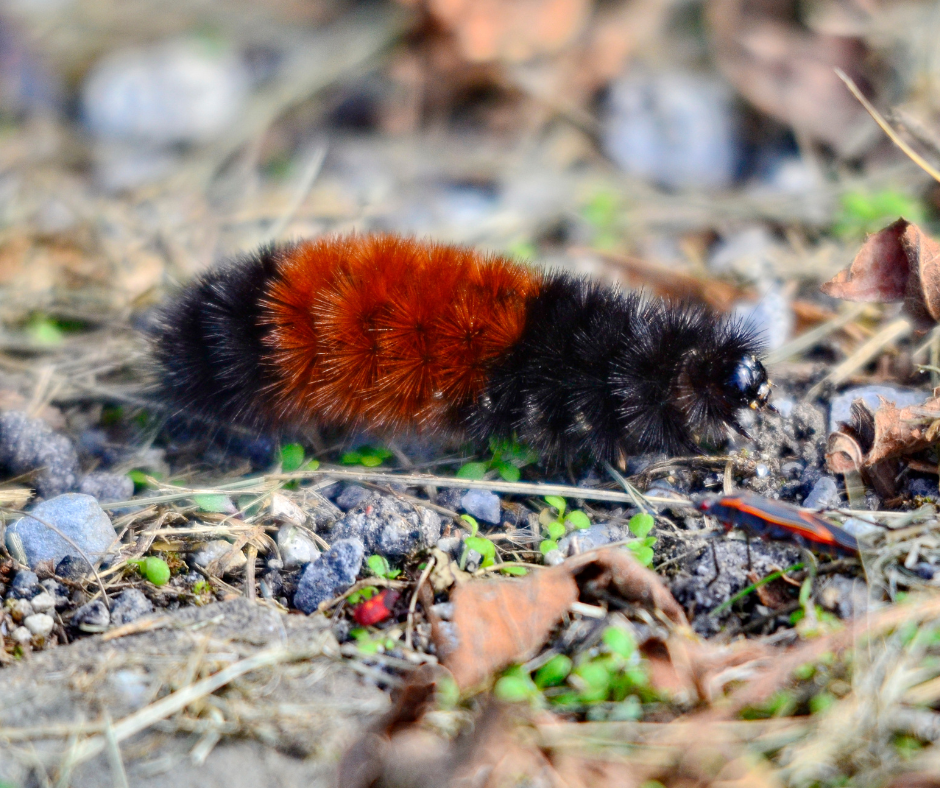With the temperature outside slowly going down, bears are getting ready for winter. Not drown or black bears, woolly bears! You may have noticed more of what many refer to as woolly bear caterpillars in the fall, but how much do you really know about these adorable insects?

There are many different types of “woolly bear” caterpillars but the most common one and the one that we’ll be referring to is the banded woolly bear that becomes the isabella tiger moth. The scientific name of these caterpillars/moths is Pyrrharctia isabella. Isabella tiger moths range from southern Canada throughout the United States and into northern Mexico. Tiger Moths are a common species found in Minnesota but are more commonly found in the fall as their larval stage as caterpillars. With black bristles or “setae” on both ends and a ring of reddish brown in the middle, these caterpillars can easily be distinguished from others.
While it has been said that the colors on a woolly bear caterpillar can be used to predict the winter, no evidence supports this theory. (The amount of black on the ends is more likely related to age.) While they may not help us prepare for the winter ahead, these amazing creatures are more than well-equipped for whatever Minnesota winters can throw at them. The setae that cover the bodies of woolly bears and give them their name are used to detect freezing temperatures. When these low temperatures are detected the caterpillar uses “cryoprotectants” to protect its vital organs. These cryoprotectants work like a natural antifreeze and according to the National Weather Service, can keep woolley bears alive at temperatures as low as -90℉. With this ability, woolly bears are even able to live in the Arctic!
Winter is not the only challenge for the woolly bear though, many predators are undeterred by the hairs that cover their bodies. Parasitic wasps, mantids, and other insects feed on woolly bears. As an adult, the moth lacks the hairs and colors that prevent some larger predators like birds from eating them. The other dangers of course are habitat loss, climate change, and toxins such as pesticides.
These moths will go through two life cycles each year, the latter being the generation that must survive the winter. After hibernating, the caterpillar will continue to eat and grow before pupating and creating a cocoon. It takes 1-3 weeks for the adult moth to emerge from the cocoon, find a mate, and lay eggs. As an adult, the female moths use a scent to attract a mate. The males fly in a zig-zag pattern to help detect this scent. Once ready the female will find a place to lay her eggs and the male will search for another mate. After hatching out of the egg, the small larva (caterpillar) begins eating, growing, and shedding. When ready it will pupate and begin the cycle over again.
At each life cycle these insects consume different food. As a caterpillar, they eat a variety of leafy plants and foliage. The adults, without the proper mouthparts to chew on plants, drink nectar from flowers. Nectar also has a high sugar content which can help give the moths the energy they need to fly. The eggs and pupal stages, of course, do not eat which makes it essential for the caterpillars to find enough food to give them energy for this transformation.
While woolly bears are very common to find at this time, there are some lookalikes to keep your eyes out for as well. The caterpillar of the giant leopard moth looks similar to banded woolly bears but is all black. It curls in defense very similar to the woolly bear revealing red bands under its setae.
This individual was recently found at Ney crawling through some leaf litter and grass:

Alternatively, you may encounter a “yellow bear” of an entirely yellow woolly bear that will become a Virginian tiger moth. No matter what the individual, I always recommend knowing what you are picking up before touching it. Some individuals such as the dagger moth have hairs that can cause stinging or itching. They can be identified by long black tufts that contrast the west of their yellow hairs. It’s important to remember that they don’t want to hurt you and can be observed with just a little space.

Even though many of our insects have left for the year, we still have time to find some that will be spending the winter here with us. And, If you’d like to help these fuzzy friends stay safe over the winter, wait until next spring to remove the leaves from your yard!
